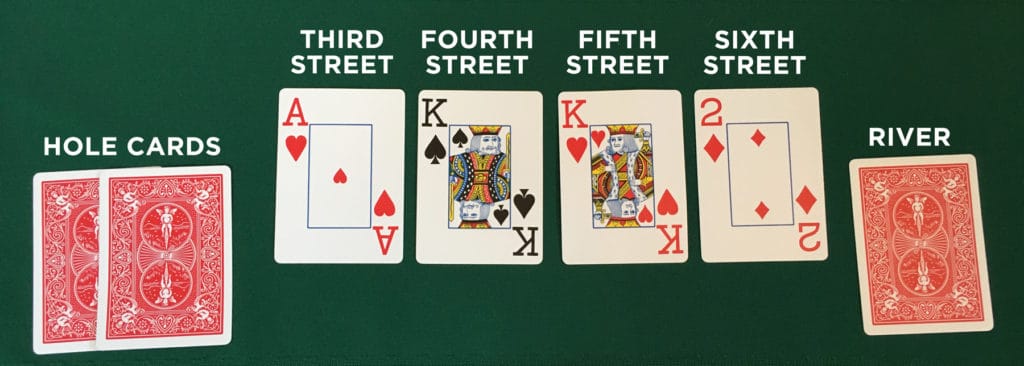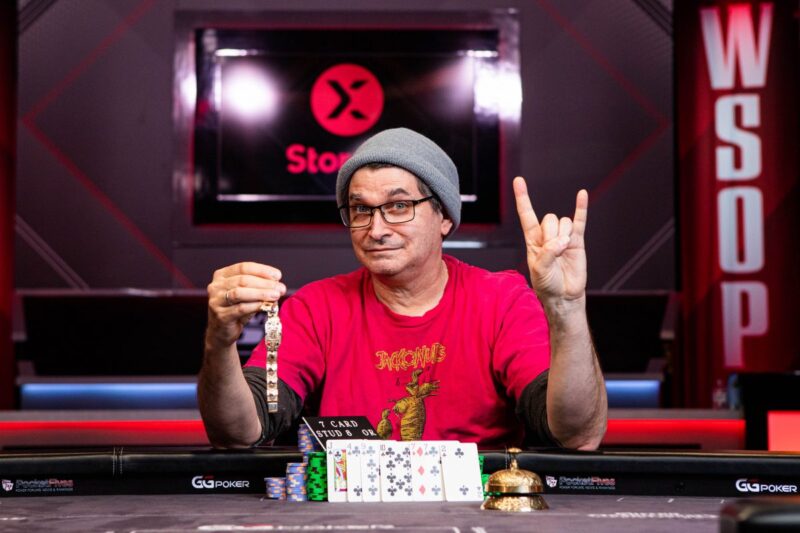Many No-Limit Hold’em players are finding themselves playing Stud these days – in home games or online, often as part of a mixed game. This article is meant as a quick tutorial of the game that should, hopefully, supply you with at least a few insights that will give you a leg up on opponents who are less familiar with the game.

Broadly speaking, Stud differs from No-Limit Hold’em in that Stud is a game of live cards, big pairs, and fixed limits. Your play needs to adjust to these realities of the game.
Betting in 7-Card Stud
Betting rounds are named for the number of cards you hold at the time. Third Street is the game’s first betting round and occurs after you’ve been dealt two down cards and an upcard (called your “door card”). The low door card starts the action with a forced bet that is generally equal to a third or a quarter of the lower tier of betting. In a $10/$20 game that’s generally $3; in a $20/$40 game, that’s $5.
After the first forced bet, other players may complete the bet by raising it to the lower tier of betting, call the bet, or fold. If they complete the bet, that completion may itself be raised by the fixed lower-tier amount.
In $20/$40 game, the $5 forced bet may be called, or completed to $20, with any subsequent raises made in $20 increments. Generally, there is a limit of three or four raises per betting round. The higher tier of betting commences on Fifth Street; though if a player shows a pair on Fourth Street, they have the option of betting either the higher or lower amount.
Third Street Strategy Tips
Your first major decision occurs on Third Street after you’ve been dealt your first three cards (two in the hole, one exposed). As a general rule of thumb, you want to complete the bet, raise, or re-raise if you believe you hold the highest hand. If, for example, you hold (A♠ 3♥) A♦, and the 2♦ brings in the bet for $3 in a $10/$20 game, you want to complete to $10. If someone has already completed the bet to $10, you want to raise to $20.
Don’t try to suck people in by calling. Raise! And if someone has raised ahead of you, re-raise. Limit the field and push that high pair.
If you don’t hold what you believe is the high pair, your tendency should be to fold. There are exceptions to consider, however. If your pair is hidden in the hole, and it is completely live you may want to call a raise, especially if other players are also likely to be in the hand. Similarly, if you have a live over-card to the exposed card of the raiser and a live pair, you can call or even re-raise that player.
Let’s say you hold (7♦ 7♠) A♦. The 4♥ brought in the bet for $3 and a couple of players have called before the J♥ raises in front of you. You can call that bet. You’re not much of an underdog and, if you hit one of the two remaining 7s giving you well-concealed trips, you’re likely to win a large pot from your opponent.
If the J♥ is held by a particularly tight player or if your image is especially rocky, you might even raise, representing that you have a pair of Aces. Your opponent may well fold to you rather than run the risk of competing to the river as second best.
A-K-x or anything worse is a trash hand in this game, though they may look good to a hold’em player. Dump these hands, even if you’re just the bring-in.
Flush draws may also be played on Third Street, but only if no more than two of your suit are dead, and only if your three-flush is headed by nothing lower than a Queen, that high card is live, and it’s higher than the card held by the raiser.
You want to be drawing not just for your flush, but also for top pair. Similarly, you can chase a straight if your straight cards are live, your straight consists of high cards, and the high cards are relatively live. If you decide not to play three-straights at all, you won’t be too far from wrong either.
Fifth Street
Your next big decision comes on Fifth Street when the bets double. You’re going to fold your draws here if they haven’t improved, and you’re going to continue to bet your high pair unless you see something scary.
For example, if any of your opponents pairs his door card on Fourth or Fifth Street and bets, you’re going to give him credit for trips, not continue with your flush or straight draws, and fold any hand you have that consists of two pair or lower.
Similarly, if you have only a pair and one of your opponents has three exposed suited cards, you’re going to fold if he bets. Even if he doesn’t yet have the flush, you’ll be drawing dead if he does. Even if he only has a four-flush, your opponent will hit it his hand more than a third of the time if his cards are live. It’s not worth continuing. Fold to a bet.
Sixth Street
In this limit form of poker, pots will generally be so engorged by the time you reach Sixth Street that it typically makes no sense to fold to a bet unless you’re certain that you are far behind.
If, for example, you’re on a live flush draw and your opponent bets, you should continue with the draw unless your opponent shows trips in which case, you should fold.
If you have two pair, even two low pair, and your opponent bets while showing three to a flush, you should call. Even though the odds of making a full house are long, the pot size and the chance that your opponent doesn’t yet have a flush is almost certain to be big enough to warrant the call.
The River
Once again, the size of the pot will be large enough to justify a call unless you’re certain — or nearly certain — that you’re beat.
Have a single pair and your opponent, who has been betting the whole way, shows no pair? Call him on the river.
Think about it. Typically, in all but the tightest of games (and you should tend to avoid very tight Stud games) the pot will be at least 10 times the size of that final bet. If you make the mistake of calling a bet and losing, you’ve made a single bet mistake. If you make the mistake of folding when you had the winning hand, you’re making at least a 10-bet mistake.
Put another way, you generally have to be 90% sure or better that you’re beat for a fold to make sense.
Summary
This brief set of tips is applicable against the novice and intermediate players typically found in small to moderate stakes games like $3/$6, $5/$10, $10/$20, and $20/$40.
In bigger games, the ante and forced bets require more aggressive play. There are many other pointers I could give you about this complicated game (get a copy of my book Winning 7-Card Stud if you’re interested). But these few should at least give you an advantage over your typical opponents.
Ashley Adams, author of Winning Poker in 30 Minutes a Day (2020), wrote the timeless classic Winning 7-Card Stud: Transforming Home Poker Chumps into Casino Killers in 2003.


